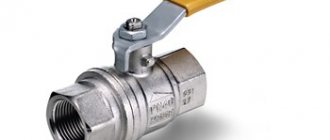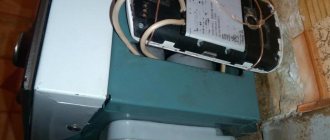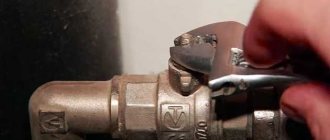Types of valves
To determine the position of the device and find out how the valve opens or closes, you first need to know the type of device installed.
In household systems the following are most often installed:
ball valves. There is a metal ball in the body of the device, which serves as a locking mechanism. The body and locking element are usually made of durable metals (brass, steel, bronze), which ensures a long period of use of the device;
Valve with ball-shaped locking mechanism
plug valves. The locking elements in this type of device are cylindrical or conical plugs. The plug valve body is also made of high-strength metal. The locking mechanism allows the valve to be used in pipelines with aggressive media.
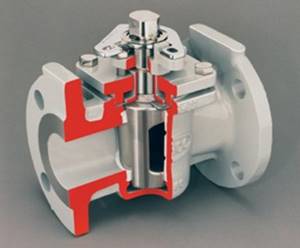
Valve with cylindrical plug
In most cases, ball valves are installed on heating and water supply systems, and plug valves on gas pipelines.
Is it possible to turn off the radiator in the summer?
All operating organizations state that they do not drain the system in the summer, but “drive” cold coolant. In reality, the system is drained: for repairs, replacement of pipes or equipment, etc. And although all radiator manufacturers say that it can stand without water for two weeks (or a week) a year, no one guarantees that the system will be filled in two weeks. This situation is not critical for copper and copper-aluminum radiators - copper generally has oxygen or not - it practically does not react to its presence in any way (after an oxide film has formed on the surface).
To avoid damage to radiators, many people close the radiators with ball valves after the end of the season. But you can’t do this: the battery can simply rupture.
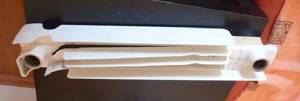
If you turn off the radiator in the summer and do not open the air vent, the battery may simply rupture
The fact is that in the presence of water in the radiator, chemical processes occur, which are accompanied by the release of gases. When the taps are closed, the possibility of their exit is cut off. Gases accumulate more and more inside, creating excess pressure. Once it exceeds its tensile strength, the battery will burst. And this will not be a warranty case: the operating conditions have been violated.
This problem is relevant for aluminum ones. cast iron, bimetallic and steel radiators. That is, for everyone. But what to do? It’s both bad and bad. And the solution is this: shut off the battery, but at the same time open the air vent.

If you turn off the radiator for the summer, make sure that the air vents are open and in working order.
Today, every modern radiator has this device. Most often - the Mayevsky crane. This is a small washer with a hole, with the help of which it is necessary to bleed air after starting the system and during the heating season. In manual models, you need to use a wrench or a screwdriver to turn the screw counterclockwise. In automatic ones, bleeding occurs as air appears. But even here there is a screw cap that blocks the exit of gases. So here it is. If you decide to shut off the battery for the summer, make sure that the air vents are open and the air is released (not clogged). It also doesn’t hurt to make sure at least once a month that the air vent is still open, otherwise you never know: the children were playing, or someone absent-mindedly twisted it...
Manufacturer Electrolux

Turning on Electrolux boilers is no different from their counterparts from other manufacturers. You need to press the power button and select a temperature that is comfortable for you.
If the boiler was configured correctly, there should be no problems connecting the device. Thank you for reading this article and we really hope that we were able to help you with the issue of turning on your water heater.
The presence of a centralized hot water supply in an apartment is, of course, a blessing. But due to the fact that the networks require repairs and maintenance, once a year the townspeople carefully study the schedule according to which their houses will be disconnected. As a rule, this happens in the warm season, and some residents bravely survive this period, using all available measures and methods: they harden themselves, heat water in large pots or electric kettles, actively begin to visit relatives and friends, etc. But meanwhile, there is a more correct solution, which can confidently be called civilized - to buy a water heater for the apartment. And for those who believe that the purchase of additional equipment takes a long time to pay off, there is also a weighty counter-argument, which we will tell you in confidence: in addition to planned outages, emergency ones often occur that do not obey any schedules. And in this case, a backup source of hot water will be an indispensable assistant.
Some features of popular systems
In order to somehow highlight their protection against water leaks, manufacturers are trying to improve reliability or come up with other moves. It is impossible to systematize these features, but it is better to know about them when choosing.
Capabilities of one block
For different manufacturers, one control unit can control a different number of devices. So it won't hurt to know this.
- One Hydrolock controller can service a large number of wired or wireless sensors (200 and 100 pieces, respectively) and up to 20 ball valves. This is great - at any time you can install additional sensors or install several more cranes, but such a reserve of capacity is not always in demand.
- One Akastorozh controller can service up to 12 wired sensors. To connect wireless, you need to install an additional unit (designed for 8 Aquawatch Radio pieces). To increase the number of wired ones, install another module. This modular expansion is more pragmatic.
- Neptune has control units of different powers. The most inexpensive and simple ones are designed for 2 or 4 taps, for 5 or 10 wired sensors. But they do not check the functionality of the taps and do not have a backup power source.
As you can see, everyone's approach is different. And these are just the leaders. There are even smaller campaigns and Chinese companies (where would we be without them) that either repeat one of the above plans or combine several.
Additional functions
Additional ones are not always unnecessary. For example, for those who are often on the road, the ability to control cranes from a distance is far from superfluous.
- Gidrolok and Akvatorozh have the ability to turn off water remotely. For this purpose, a special button is placed at the front door. Go out for a long time - press and turn off the water. Aquawatch has such a button in two versions: radio and wired. Gidrolok has only wired ones. The Aquastore radio button can be used to determine the “visibility” of the wireless sensor installation location.
- Hydrolock, Akvastorozh and some Neptune variants can send signals to the dispatch service, security and fire alarm systems, and can be built into the “smart home” system.
- Hydrolock and Akvastorozh check the integrity of the wiring to the taps and their position (some systems, not all). In Hydrolock, the position of the locking ball is controlled by an optical sensor. That is, when checking there is no voltage in the tap. The Aqua Watchman has a contact pair, that is, at the time of testing, voltage is present. Protection against water leaks Neptune also monitors the position of the taps using a contact pair.
The hydrolock can be controlled using a GSM module - via SMS (commands to turn on and off). Also, in the form of text messages, signals about accidents and “disappearances” of sensors, broken cables to electric taps and malfunctions can be sent to the phone.

Always being aware of the condition of your home is a useful option.
On the issue of reliability: power supply and other issues
Reliable operation does not only depend on the reliability of the cranes and controllers. Much depends on the power supply, on how long each unit can operate autonomously.
- Aquawatch and Hydrolock have backup power sources. Both systems shut off the water before the backup power supply is completely discharged. Neptune has batteries only for the last two models of controllers, and then the taps do not close when discharged. The rest - earlier and less expensive models - have a 220 V power supply and no protection.
- Neptune's wireless sensors operate at a frequency of 433 kHz. It happens that the control unit “does not see” them through the partitions.
- If the batteries in the Gidroloka wireless sensor run out, the alarm on the controller lights up, but the taps do not close. The signal is generated several weeks before the battery is completely discharged, so there is time to change it. In a similar situation, the Aqua Watchman shuts off the water. By the way, the Hydrolock battery is soldered. So changing it is not so easy.
- Aquawatch has a lifetime warranty on any sensors.
- Neptune has wired sensors that are installed flush with the finishing material.
We looked at all the features of the three most popular manufacturers of water leakage protection systems. In short, the worst thing about the Aquawatch is the plastic gearbox on the drive; the worst thing about the Hydrolock is the high power of the system and, accordingly, the price. Neptune - inexpensive systems are powered by 220 V, do not have a backup power source and do not check the functionality of the taps.
Naturally, there are Chinese leakage protection systems, but you should choose them with caution. https://www.youtube.com/embed/EW3HuvRojwA
... ball valve
A ball valve (ball valve) has in its design either a handle (handle) or a butterfly handle. The position of the handle axis determines whether the mechanism is closed or open. If the axis of the handle is parallel to the axis of the tap and the pipe on which it stands, then it is open (Photo 1). And if the axis of the handle is perpendicular (at an angle of 90 degrees) to the axis of the ball valve, then it is closed (Photo 2). And the protrusions on the body limit rotation to a certain angle for the convenience of maximum opening - “counterclockwise” or closing - “clockwise”.

People often forget in what position they have an angle ball valve installed on a water supply, for example, for a washing machine (Photos 5 and 6).

Sometimes it happens that the handle is broken or missing, and how do you understand what position the ball-type mechanism is in? By the groove(s) on the stem (Photo 7) you can recognize the position of the valve by analogy, as with the handles (Photo 8).
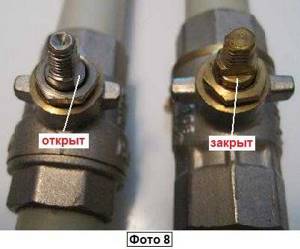
What to do if the fluid leaks
The problem of faulty plumbing worries many; even on the Internet you can often find queries on this topic, for example, “faucet is leaking, how to fix it, video.” Meanwhile, most faults are easily fixed.
Currently, the most common are single-lever faucets with a cartridge (faucet axle box). Both hot and cold water in such a mixer are turned on by lifting a single lever. Most often, incorrect operation of faucets of this type is caused by a cartridge that has become unusable. In this case, you just need to replace the cartridge with a new one. For repairs, you will need a small flathead screwdriver, an adjustable plumber's wrench and a new cartridge.
The faucet is leaking in the bathroom or kitchen. Procedure:
- Turn off hot and cold water.
- Remove the upper part of the lever-handle.
- If there is a protective clip blocking access to the screw, remove it.
- Use a screwdriver to unscrew the screw.
- Now carefully remove the lever and unscrew the decorative cover covering the cartridge nut.
- Using an adjustable wrench or a suitable wrench, unscrew the nut and remove the cartridge by hand.
- Insert a new cartridge and repeat all steps in reverse order.
- All that remains is to restore the water supply and check the operation of the tap.
Replacing a current riser tap
Your main valve has been disconnected, your pipes are empty, and you've grabbed a new valve and you're ready to start. Make sure you have all the necessary tools. Depending on whether you are removing or installing, you may need: a pipe wrench, spanner, pliers, pipe cutter, and/or tip puller.
Once you've removed the old valve, installing a new one will seem like a familiar process. Attach the new valve to the pipe and (depending on the type of valve you choose) use a wrench to make sure it is installed correctly and securely.
Once the valve is in place, turn the water supply back on. Make sure the fittings are tight, tighten them with a wrench, then turn the main valve back on. Test your newly installed valve to make sure it is working and check for leaks.
Installing a new shut-off ball valve may seem like a daunting process, but even a beginner can do the job with a little preparation.
How to shut off a heating riser
The heating riser belongs to common property. It must be blocked by employees of the service organization who have the right to do so.
If you follow the letter of the law, you must come to the DEZ, Housing Office, DEU, etc. write an application, pay for the service at the cashier. At a certain time (indicate in the application) a representative of the service organization must come and turn off the valve in the basement.
How much does it cost to turn off the heating riser? This is not an easy question. The fact is that there are no fixed prices. There is a price list for services, but it is only a recommendation. In reality, each organization sets its own prices. On average, you will have to pay from $15 to $20 for this operation.
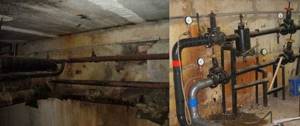
The valve that shuts off the heating supply is located in the basement of the house
There is a workaround. Agree with neighbors and shut off the riser yourself without the campaign’s knowledge. But you know that this is not always possible: neighbors are different. If in the summer, when the heating is turned off, such actions may meet with understanding, then during the season - it is unlikely. There is another difficulty: the heating valve is not always easy to find. You either need to have a communication scheme, or just know where it is. They usually know a locksmith. But they won’t block the riser for free, and will require at least $10-15. There seem to be savings, but they are small. And if this fact becomes known to the management or operational company, you will face substantial fines.
What is this service?
By and large, the service is a simple tightening of the valve of one of the water supply pipes to block the flow. If something breaks or a pipe simply needs to be replaced, you need to make sure that no one is flooded, including the direct customer of the service. There are disputes that, in theory, it is legally prohibited to charge money for shutting off the water, but for now we only have what we have.
In addition, you usually have to negotiate separately with the craftsmen on site so that they do this, because permission from above may simply not be given, citing the fact that they do not see sufficient grounds for blocking the riser. This service can otherwise be called a regular water shutdown, but only in the entire entrance at least.
Who to entrust the work to?
Since you will still have to pay, it is better to do everything at once. In any case, with all the radiators on one riser. And here the question arises: who will carry out this work. To get started, you can go to the housing office or departmental office and ask about their prices. As a rule, the prices there are rather high, and the quality of work is not up to par. To make sure of this, you can ask neighbors who have already dealt with them.
You can find a private owner. Just not from advertisements, but from the recommendations of acquaintances, colleagues, friends. Their prices are rarely higher than those of operators. And the quality is better - this is their bread: if they do a bad job, there will be no customers. That’s why they try (if they are sane) to do everything conscientiously.
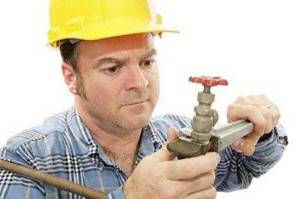
Choosing a performer is not an easy task
There is still an opportunity to negotiate with the housing office employee by bypassing the cash register. But here the option is controversial. Firstly, they tend to ask for a price based on the client’s wealth and it is far from a fact that they will demand less than the price list. More likely - more. Why, tell me, should they pay more for the same quality of work (it is unlikely that they will work more diligently than at their main job)?
Another option is to contact a specialized organization. And again, preferably based on recommendations. Although, organizations are forced to monitor the quality of work for prosaic reasons: they need clients. If they have a bad reputation, no one will go to them
Therefore, if you don’t know the organization, there are no recommendations, you can pay attention to the period of its existence on the market. If it’s not a year or two, then they definitely know how to do something, otherwise they wouldn’t have existed for so long
Naturally, pay attention to the services they provide. Many people suggest that issues with permission and disconnection of risers should be handled by the management or operating organization. You just specify the list of works and time. How expensive will it cost? In different ways: organizations, like their leaders, are different. It may be more expensive than the work of a mechanic from the housing office, but at least you will have someone to file a claim with in case of problems: you sign an agreement that will clearly outline who is doing what.
And the most economical option: do everything yourself, with your own hands. It’s not an easy task, but it’s not the gods who burn the pots. Just first you need to find out everything down to the smallest detail, purchase everything you need, prepare tools and equipment, and only after that write an application to turn off the riser.
This all concerned planned repairs or preventive maintenance. If a radiator or pipe is leaking, you definitely have to take action yourself. Read how to fix a radiator leak here.
What is a tap that shuts off the water in an apartment or house, where is it located and how to change it?
If you are a home owner, or have been lucky enough to never have a plumbing problem, you may not be aware of shutoff valves that shut off the water. These simple valves control the flow of water to fixtures such as showers, toilets, sinks, and washing machines. They have two pipe connections: one large inlet connection in the back that connects to your main water pipe, and a smaller outlet that connects to the pipe leading to your appliances.
Ideally, you should have a shut-off valve for each device. This way, you can turn off a leaking faucet for a few hours (or a few days if necessary) until it can be repaired while using your shower or toilet. They are usually located close to the fixture, such as under the sink or behind the toilet.
In some cases, you may have one valve for the entire room, or even one for the entire house. If you only have one for your entire home, you can install multiple valves more locally.
Now that you can answer the question - "What is a shut-off valve?" - you still need to answer a few questions before you can install one.
- Do you know where the main shut-off valve for your home is located?
- What are water pipes made of?
- How are water pipes oriented in relation to the fittings?
- Are you replacing an old shutoff valve or installing it in a new location?
- You will need to do the preparatory work based on these various options, such as purchasing the right pipes and equipment.
- Turn off the water
Before you do any plumbing work, make sure you know where the main shut-off valve is for your home's water supply. After you turn off the main water supply, turn on the faucet at the lowest level of your home to drain the water from the pipes.
The next thing to do is to unscrew the water supply line from the old valve if you are replacing it, or the main water line if you are installing a shutoff valve in a new location. Now you are ready to go.
If you are replacing an old, leaking valve on copper pipes, you will need to find out what type of connection it has so you can remove it. If the old valve is soldered on further, then you need to cut the valve off. Be sure to leave yourself enough pipe left between the wall and the end of the pipe to install the new valve. (As with all home improvement jobs, such tasks require knowledge and skills that may seem risky; don't hesitate to call a plumber.)
The easiest way to remove the ferrule and nut from a pipe is with a tool called a sleeve puller, which screws onto the pipe just like a valve, and then pulls the ring and nut off the pipe with a few turns of a wrench. You can also remove the old ferrule using a pair of wrenches by lifting it off the pipe, which is just as effective but may take a little more work.
Eliminating whistling, humming and noise
In addition to a banal leak, the following problems are quite common: the tap turns; weak water pressure in one of the taps; noises that appear when the water is turned on.
First, let's figure out why the faucet whistles (or hums). Noises can be caused by a worn gasket on the faucet valve or a poor-quality cartridge on the mixer. Change the gasket to a new one (made of thick rubber) or a low-quality faucet axle box to a ceramic product from a reliable manufacturer and the whistle when turning on the water will disappear.
What to do if the water from one tap flows in a weak stream? Presumably, the problem can be caused by a clogged coarse filter installed on the mixer or tap. It is enough to clean and rinse the filter and the water pressure will be restored. The reason may be even more trivial - a clogged mesh on the faucet tap; it can be easily unscrewed and washed.
Valves rotate due to worn threads or a leaky gasket on the valve head. This happens due to torn or worn threads. To eliminate the problem, replace the valve with a new one. If the thread is in order (this can be seen during disassembly), simply change the gasket.
How to shut off the battery
To perform some work, you only need to turn off the radiator:
If shut-off valves are installed - ball valves. This is easy to do: you need to turn the tap handle until it stops on the supply and return pipes. The coolant flow is blocked, the heater can be removed.

If there are ball valves in front of the radiator, close them and remove the radiator
Sometimes a manual control valve is installed at the supply. It can also shut off the coolant supply, but its main function is to regulate: it is installed to maintain a constant temperature in the room.
If the heating season is over, after closing the taps, you can safely remove the radiator. If there is a need to carry out work during the heating season, it is necessary to take into account the peculiarities of the installation. In a single-pipe system with vertical distribution, shutdown without stopping the system is possible only if there is a bypass.
A one-pipe system with vertical wiring looks like this: one pipe comes out of the ceiling, goes to the radiator, the second comes out of another hole in the battery and goes to the floor.
The bypass is a jumper placed in front of the radiator. It connects the supply and return pipes. It is usually carried out with a pipe size one step smaller than the diameter of the liner.
If there is a bypass, then when the radiator is turned off, the coolant continues to circulate through the riser, but already flows through this jumper. As a result, no one suffers: the neighbors are warm, you carry out the required work.
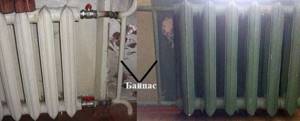
The bypass is a jumper in front of the battery. In the photo on the right, even though there is a bypass, there is nothing to shut off the battery: there are no ball valves
When connecting using a two-pipe scheme, there are no problems: there are taps, close them, remove the radiator. With a single-pipe system, but with horizontal wiring, jumpers are also needed. But, in their absence, you will freeze your apartment.
In general, a bypass is a very necessary element: if necessary, it allows you to install a thermostat (thermostat) at the inlet of the radiator, with which you can maintain a constant temperature in the room. Without this jumper, installation of control devices is prohibited. It’s just that without it, it turns out that you regulate not only the temperature of your battery, but also the entire riser, which is unlikely to please your neighbors.
But just the presence of a bypass does not guarantee the ability to turn off the battery during the heating season. There should also be ball valves on the supply and return. Moreover, it is better to take full-bore valves for heating radiators. There are also standard ones. In them, the clearance in the open position is approximately 70-80% of the diameter. In full bore models it is 100%. To ensure normal heat transfer, they are exactly what is needed.

The battery can be disconnected at any time if there are ball valves at its inlet and outlet. But to ensure that heat transfer does not decrease, it is necessary to install full-bore models
If there is no bypass, to carry out all this work you will have to turn off the riser, and this is not done soon, and even at a cost.
Manufacturer Ariston
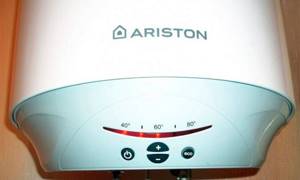
How to turn on the Ariston boiler? First of all, you will need to fill the boiler with water and connect the device to the power supply. Within the first couple of minutes, the indicator panel will start working. At the moment, your boiler is not yet turned on, as indicated by flashing temperature indicators.
In order for the device to start working, press the “turn on” button; on the display you will see the current water temperature in the tank. In order to select the temperature you need, press the “+” or “-” buttons; by pressing any of these keys, you will switch to the temperature selection mode. The temperature is available in the range from 35 to 70 degrees.
The manufacturer also equipped its models with the ability to change the available power: 1500 or 2500 W. You can activate this setting by pressing the “power” button for a couple of seconds. The boiler does not have a memory function, so when it is turned off, the settings will be reset.
The Ariston mechanical model has even more simplified controls. After you have connected the boiler to the power supply, press the “turn on” button - it will light up red. As soon as the water reaches the desired temperature, the power button will go out.
The power of the mechanical model can also be increased. Its main feature is that while the water heater is operating, the red shutdown button lights up. As soon as the device stops working, the button goes off. This immediately lets us know that the water is ready for use.
Manufacturer Thermex
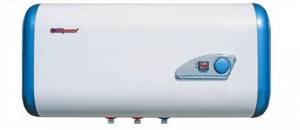
Let's move on to consider how to turn on the Thermex boiler? After the device has been connected to the mains, you need to select the desired temperature mode. If after 25 minutes the indicators on the display change and heated water comes out of the tap, then the device is connected correctly and you can only wait for the liquid to heat up to the desired temperature.
How to turn off the water
This can be done in a separate apartment only if there are special valves in the bathroom. But this method is appropriate only when minor work is planned. For example, repair a faucet. If you plan to install plumbing in a toilet/bathroom or other labor-intensive work, you must shut off the water along the entire length of the riser. This design is a pipeline. The riser is intended for 1-2 apartments.
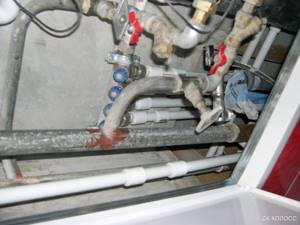
Shut off using a tap
If there is a valve in the bathroom, you should turn it clockwise until the end. What to do if the apartment is old and there is no valve? In this case, you will inevitably have to contact a specialist from the housing office. The plumber will not be able to turn off the water in a single apartment, only in the entire entrance.
In the event that a main pipe bursts, the entire house is shut off. This work may even affect several buildings.
The pipes in the bathroom and toilet located in new buildings usually have valves. Using them you can easily turn off the water in a separate apartment. In other cases, there is even a special sensor on the pipes that automatically detects problems and turns off the structure.
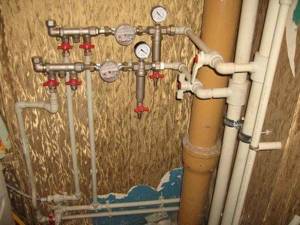
How to turn off the water in the toilet riser?
The riser is usually located in the toilet or kitchen. Its main purpose is to supply water. It can be overlapped only if there are valves on the structure. If they are not there, you need to think about installing the elements. The best choice in this case would be ball valves.
If old elements with defects are installed on the pipeline, it is better to think about replacing them, because in the event of an emergency they may fail and you will flood your neighbors. It is better to entrust their installation to a specialist. A plumber will be able to determine what diameter of the product is required specifically for your riser.

After installing the valves, you must not forget about the importance of preventative maintenance. Once every three months it is recommended to turn off the risers and then turn them on again
This is necessary so that the elements do not stagnate and cope well with all their functions. It is better to prevent their breakdown, because in an extreme situation the valves may fail, and you will not be able to do anything about it. If any problems arise, it is better to call a technician who will check the condition of the valves and carry out the necessary repair work.
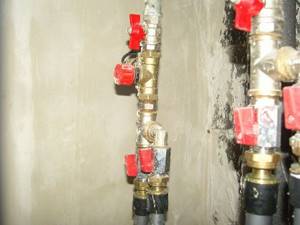
In conclusion, we can say that turning off the water is easy only if a person takes care of it in advance. If the valves have not been installed, it is almost impossible to turn off the valve in one apartment. For this reason, it is better to get ahead of the occurrence of further problems and install them, because shutdown may be required not only during repair work, but also in the event of emergency situations.
https://trubygid.ru
How to fix a leak in a pressurized water pipe
Of all the possible breakdowns that occur in a house or apartment, a pipeline accident is one of the most unpleasant.
Moreover, if in the event of a leak in cold or hot water pipes, you can simply shut them off and calmly begin repairs, then a fistula in the heating system requires immediate elimination.
Otherwise, very unpleasant consequences may arise:
- burns from exposure to hot coolant;
- damage to furniture, wall decoration and flooring;
- flooding of neighbors (in the case of a multi-storey building).
And all this is accompanied by vanity, confusion and a host of other negative emotions. Therefore, it is better to prepare for an emergency in advance. It is impossible to provide for all options, but it is still better to have some devices and materials in the house.
Causes of leaks in pipelines
In order to effectively cope with an unpleasant situation, you need to understand the cause of the leak.
There are several reasons:
- Mechanical damage to the pipe. Not a single pipe, even a metal one, let alone a polypropylene or plastic one, can withstand serious physical impact. It is for this reason that they try to lay pipelines in places where there is no intensive access to them.
- Violation of pipeline installation technology. The weak point of a steel pipeline is its welds and threaded connections. Metal-plastic and polypropylene, subject to temperature deformation, can depressurize due to incorrectly selected parameters of the system elements, as well as if they are connected and installed incorrectly.
- Corrosion of a steel pipeline caused by the interaction of water circulating in the pipeline and the external environment. The resulting condensate, penetrating into unprotected communication nodes, gradually destroys them.
If a leak occurs anywhere in the main line, first of all you need to decide for what period of time the accident should be eliminated.
If you just want to wait for the emergency team to arrive, then you can simply limit yourself to removing the leaking water. If you need to somehow wait until the end of the heating season, then more serious measures will have to be taken.
Do not deceive yourself: high-quality repair of heating pipes is only possible with an empty heating system.
Methods for eliminating pressure pipe leaks
There are not many such methods. After all, when water circulates in a pipe, the most reliable ways to eliminate an accident are simply not available: there is no way to replace the defective section or use welding.
The most popular methods include the following:
- installation of a clamp;
- screwing a self-tapping screw into the hole on the pipe;
- cementation of the crack;
- emergency glue;
- using a bandage and table salt.
Repairing a pipe by installing a clamp
This is the most reliable and easiest way to eliminate accidents on both water and heating pipes.
Every self-respecting home handyman should have several clamps in stock. They are sold in construction markets and in specialized plumbing departments. It is better to have clamps of different sizes according to the diameters of the pipes present in the house.
